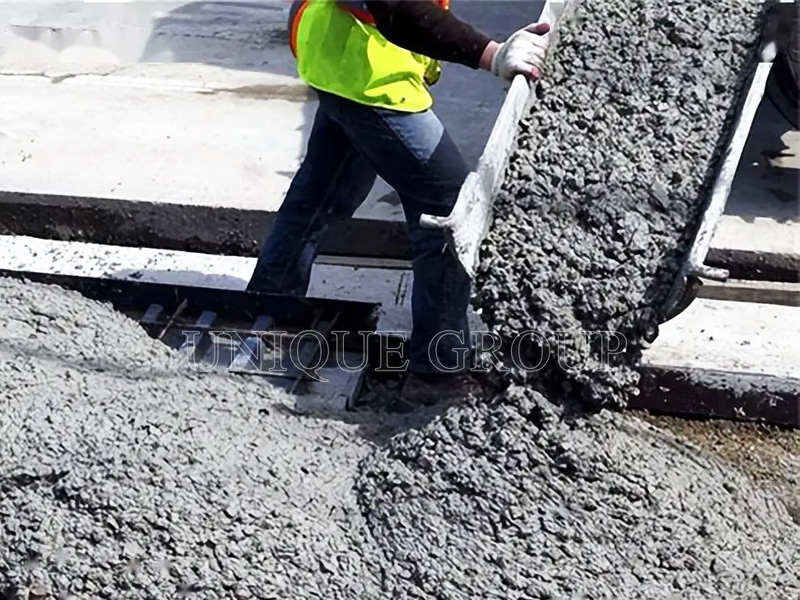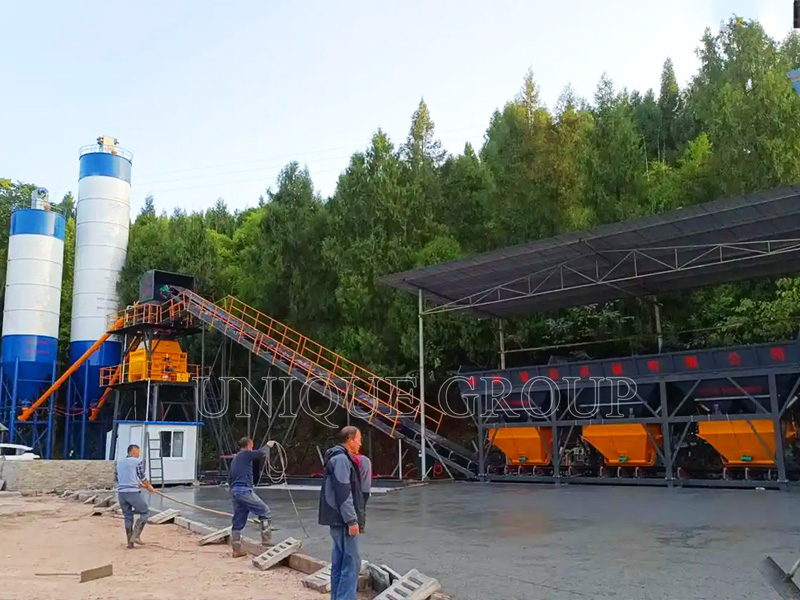In an era marked by soaring construction material costs, growing demand for sustainable building practices, and the need to expand infrastructure in resource-constrained regions, traditional concrete—while durable—often becomes a prohibitive choice. This is where
poor man’s concrete emerges as a game-changing alternative. As a cost-effective, adaptable, and eco-friendly substitute for traditional concrete, it has become a go-to solution for rural infrastructure, DIY projects, and budget-conscious construction. For industry leaders like
Unique Group—a global provider of construction machinery and soil stabilization technologies—poor man’s concrete is not just a “budget hack” but a catalyst for accessible, sustainable development. This guide breaks down what poor man’s concrete is, its applications, benefits, and how Unique Group’s innovations make it more effective than ever.
At its core,
poor man’s concrete (also known as
soil cement) is a non-structural, compacted mixture of Portland cement, locally sourced soil, and minimal water—with optional aggregates like gravel or crushed stone for added strength. Unlike traditional concrete, which requires precise ratios of cement, sand, coarse aggregate, and water (often 1:2:3:0.5), poor man’s concrete prioritizes adaptability to local conditions, making it far more forgiving and affordable.
The success of poor man’s concrete lies in its simple, locally focused ingredients:
Portland Cement: The binding agent. Typically used at a ratio of 1 part cement to 5–8 parts soil/sand (by volume). This is significantly less cement than traditional concrete, slashing material costs.
Native Soil: The primary “filler.” Ideal soils include loam, sandy loam, or clay-loam—soils that can compact tightly without excessive cracking. For heavy clay soils, adding a small amount of sand (10–15% of soil volume) improves workability; for sandy soils, mixing in clay helps with binding.
Water: Just enough to moisten the mixture (often 5–8% of total volume). The goal is a “damp sand” consistency—when squeezed, the mix holds its shape but does not release water. Too much water weakens compaction; too little reduces binding.
Optional Aggregates: Crushed stone (3/4-inch or smaller) or gravel can replace 20–30% of the soil to boost load-bearing capacity for light traffic (e.g., driveways).
Soil Preparation: Remove organic matter (roots, leaves) and large rocks from native soil—these can cause uneven compaction or cracking.
Mixing: Combine cement, soil, and optional aggregates dry first, then add water gradually until the desired consistency is reached. For small projects, this can be done by hand; for larger jobs, Unique Group’s portable mixers streamline the process.
Compaction: Spread the mixture in 4–6 inch (10–15 cm) layers, then compact using manual tools (tamper) or mechanical equipment (e.g., Unique Group’s compact rollers). Proper compaction is critical—it eliminates air pockets and creates a dense, hard surface.
Curing: Moisten the surface daily for 7–10 days. Avoid heavy rain during curing, as it can wash away the cement paste.
The term “poor man’s concrete” is not a reflection of quality—it highlights accessibility and affordability for those who cannot afford traditional concrete or face logistical barriers to sourcing it. Here’s why the name sticks:
Low Material Costs: By leveraging locally available soil, it reduces reliance on expensive imported aggregates (sand, gravel) and uses 50–70% less cement than traditional concrete.
Minimal Transportation Needs: Traditional concrete requires transporting cement, sand, and aggregate to sites—often costly in rural or remote areas. Poor man’s concrete uses on-site soil, cutting transport expenses by up to 60%.
No Specialized Labor: Unlike traditional concrete, which demands skilled workers to manage mixing and pouring, poor man’s concrete can be installed by DIY enthusiasts, farmers, or local communities with basic training.
Ideal for Low-Budget Projects: It excels in non-critical applications (e.g., garden paths, shed foundations) where traditional concrete’s structural strength is unnecessary—making it perfect for rural households, developing countries, and temporary installations.
Poor man’s concrete is not designed for load-bearing structures (e.g., building columns, bridges). However, it is highly effective for light-duty, non-structural projects across residential, agricultural, and rural infrastructure. Below are its most common uses:
For example, farmers in India use poor man’s concrete to pave access roads to their fields, while homeowners in the U.S. rely on it for shed foundations—saving up to $3 per square foot compared to
traditional concrete.
While poor man’s concrete is simple in concept, its durability and performance depend on two factors:
optimal soil-cement mixing and
proper compaction. This is where Unique Group— a leader in construction machinery and soil stabilization—adds value. The company’s solutions address the biggest pain points of poor man’s concrete (e.g., cracking, low durability) and make it scalable for small to medium projects.
Unique Group’s soil stabilizers and additives are engineered to enhance the binding properties of native soil, turning ordinary dirt into a more durable surface:
Cement-Augmenting Additives: These products (e.g., calcium chloride-based stabilizers) reduce the amount of cement needed by 10–15% while improving compressive strength. They also minimize cracking by increasing flexibility.
Clay Soil Stabilizers: For regions with heavy clay (e.g., East Africa, Southeast Asia), Unique Group’s lime-based stabilizers break down clay particles, improving drainage and preventing swelling/shrinking—common causes of poor man’s concrete failure.
Anti-Erosion Coatings: A clear, water-based sealant that protects cured poor man’s concrete from rain, UV rays, and freeze-thaw cycles. This extends the surface’s lifespan by 2–3 years.
Unique Group designs machinery specifically for the needs of poor man’s concrete projects—especially in remote or off-grid areas:
Portable Soil-Cement Mixers: Small, diesel or electric-powered mixers (5–10 cubic feet capacity) that mix cement, soil, and water evenly. They are lightweight (under 500 lbs) and can be transported via pickup truck or tractor.
Walk-Behind Compactors: Ideal for small projects (e.g., paths, shed foundations). These compactors exert 3,000–5,000 lbs of force, ensuring dense compaction without damaging surrounding areas.
Tow-Behind Rollers: For larger projects (e.g., rural roads), these rollers attach to tractors and compact 4–6 inch layers in a single pass. They are fuel-efficient and require minimal maintenance.
Unique Group does not just sell products—it partners with clients to optimize poor man’s concrete for their specific conditions:
Soil Testing: The company’s team tests local soil samples to recommend the ideal cement-to-soil ratio, additives, and compaction methods. For example, sandy soils in Australia may require 1:6 cement-soil ratios, while clay soils in Brazil need 1:8 ratios with lime additives.
On-Site Training: Engineers provide hands-on training for communities or contractors, teaching proper mixing, compaction, and curing techniques.
Project Design: For municipal projects (e.g., rural road stabilization), Unique Group designs custom plans—including drainage systems to prevent water damage and sealant schedules to maximize durability.
For
budget-conscious, sustainability-focused builders, poor man’s concrete offers four unbeatable benefits:
As mentioned, it costs 50–70% less than traditional concrete. For a 10x10 ft shed foundation, traditional concrete costs $800–$1,200, while poor man’s concrete costs just $200–$400 (including cement, additives, and rental of a small compactor).
Reduced Carbon Footprint: Traditional cement production accounts for 8% of global CO₂ emissions. Poor man’s concrete uses less cement, cutting carbon emissions per square foot by 40–50%.
Minimal Resource Depletion: It eliminates the need to mine sand or gravel—resources that are increasingly scarce in many regions.
Low Waste: The mixture is mixed on-site in small batches, reducing leftover material and construction waste.
No Special Skills Needed: With basic training, anyone can mix and compact poor man’s concrete.
Simple Repairs: Cracks or potholes can be fixed by mixing a small batch of soil-cement, filling the damage, and recompacting—no need for professional repair crews.
It adapts to almost any climate or soil type:
Tropical Regions: Adding a water-resistant additive (like Unique Group’s anti-erosion coating) prevents rain damage.
Arid Regions: Using slightly more water during curing keeps the mixture from drying out too quickly.
Temperate Regions: A thin layer of sealant protects against freeze-thaw cycles (though it is still not ideal for areas with harsh winters).
Poor man’s concrete is not a one-size-fits-all solution—but Unique Group’s innovations address its key limitations:
A prime example of poor man’s concrete’s impact is a 2-kilometer rural road project in central Uganda. Prior to the project, the road was a muddy track that became impassable during the rainy season, cutting off 5,000 farmers from markets.
Local soil was heavy red clay—prone to swelling when wet and shrinking when dry. Traditional concrete was too expensive ($150,000+ for the road), and gravel roads required monthly maintenance ($5,000/month).
Soil Testing: Samples revealed the clay needed lime-based stabilizers to reduce swelling.
Mix Design: Recommended 1:8 cement-to-soil ratio with 5% lime additive.
Equipment: Supplied a tow-behind roller and portable mixer, plus 100 kg of soil stabilizer.
Training: Trained 20 local workers on mixing, compaction, and curing.
The road withstood 6 months of heavy rains without mud or potholes.
Maintenance costs dropped from $5,000/month to $500/year (for annual sealant application).
Farmers saved 3 hours of travel time to markets, increasing their income by 25%.
Poor man’s concrete is a testament to how simplicity and sustainability can solve global construction challenges. It is not “inferior” to
traditional concrete—it is a
specialized solution for projects where cost, accessibility, and eco-friendliness matter most.
With the right support—like Unique Group’s soil stabilization technologies, compact equipment, and technical expertise—poor man’s concrete becomes even more powerful. It empowers rural communities to build essential infrastructure, helps DIY enthusiasts complete projects on a budget, and reduces the construction industry’s carbon footprint.
Whether you’re a farmer paving a driveway, a municipality stabilizing rural roads, or a homeowner building a shed foundation, poor man’s concrete offers a smart, affordable path forward. And when you’re ready to maximize its durability and efficiency, Unique Group has the tools, materials, and know-how to make your project a success.

